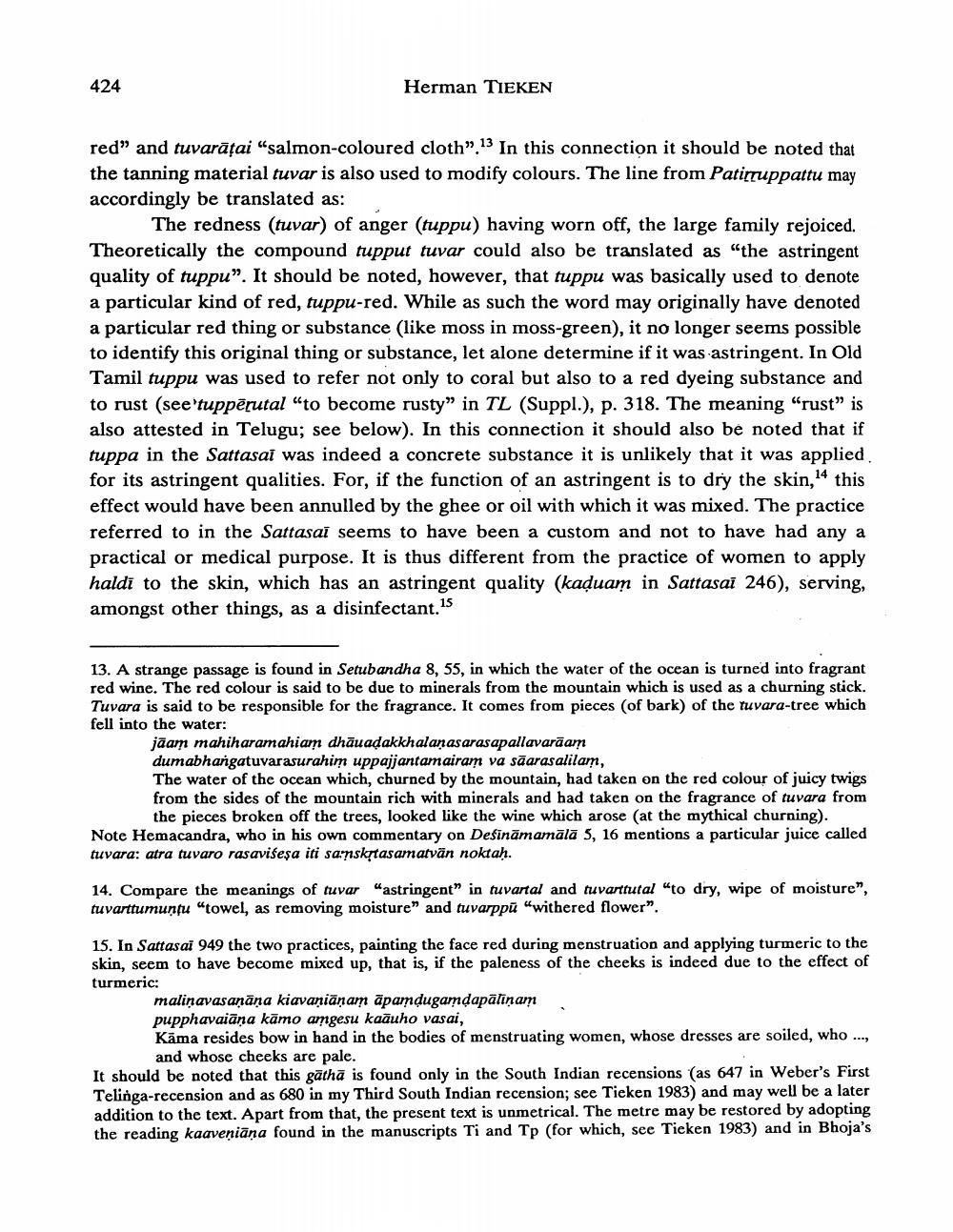________________
424
Herman TIEKEN
red" and tuvarățai "salmon-coloured cloth".13 In this connection it should be noted that the tanning material tuvar is also used to modify colours. The line from Patiruppattu may accordingly be translated as:
The redness (tuvar) of anger (tuppu) having worn off, the large family rejoiced. Theoretically the compound tupput tuvar could also be translated as "the astringent quality of tuppu". It should be noted, however, that tuppu was basically used to denote a particular kind of red, tuppu-red. While as such the word may originally have denoted a particular red thing or substance (like moss in moss-green), it no longer seems possible to identify this original thing or substance, let alone determine if it was astringent. In Old Tamil tuppu was used to refer not only to coral but also to a red dyeing substance and to rust (see'tuppērutal "to become rusty" in TL (Suppl.), p. 318. The meaning "rust" is also attested in Telugu; see below). In this connection it should also be noted that if tuppa in the Sattasai was indeed a concrete substance it is unlikely that it was applied for its astringent qualities. For, if the function of an astringent is to dry the skin," this effect would have been annulled by the ghee or oil with which it was mixed. The practice referred to in the Sattasai seems to have been a custom and not to have had any a practical or medical purpose. It is thus different from the practice of women to apply haldi to the skin, which has an astringent quality (kaduam in Sattasal 246), serving, amongst other things, as a disinfectant.15
13. A strange passage is found in Setubandha 8, 55, in which the water of the ocean is turned into fragrant red wine. The red colour is said to be due to minerals from the mountain which is used as a churning stick. Tuvara is said to be responsible for the fragrance. It comes from pieces (of bark) of the tuvara-tree which fell into the water:
jāam mahiharamahiam dhāuaḍakkhalanasarasapallavaraam dumabhangatuvarasurahim uppajjantamairam va saarasalilam,
The water of the ocean which, churned by the mountain, had taken on the red colour of juicy twigs from the sides of the mountain rich with minerals and had taken on the fragrance of tuvara from the pieces broken off the trees, looked like the wine which arose (at the mythical churning). Note Hemacandra, who in his own commentary on Deśīnāmamālā 5, 16 mentions a particular juice called tuvara: atra tuvaro rasavisesa iti sanskṛtasamatvän noktaḥ.
14. Compare the meanings of tuvar "astringent" in tuvartal and tuvarttutal "to dry, wipe of moisture", tuvarttumuntu "towel, as removing moisture" and tuvarppu "withered flower".
15. In Sattasai 949 the two practices, painting the face red during menstruation and applying turmeric to the skin, seem to have become mixed up, that is, if the paleness of the cheeks is indeed due to the effect of turmeric:
maliņavasaṇāṇa kiavaniānam āpamḍugamḍapālīnam pupphavaiāņa kāmo amgesu kaauho vasai,
Kama resides bow in hand in the bodies of menstruating women, whose dresses are soiled, who ..., and whose cheeks are pale.
It should be noted that this gatha is found only in the South Indian recensions (as 647 in Weber's First Telinga-recension and as 680 in my Third South Indian recension; see Tieken 1983) and may well be a later addition to the text. Apart from that, the present text is unmetrical. The metre may be restored by adopting the reading kaaveniāņa found in the manuscripts Ti and Tp (for which, see Tieken 1983) and in Bhoja's




